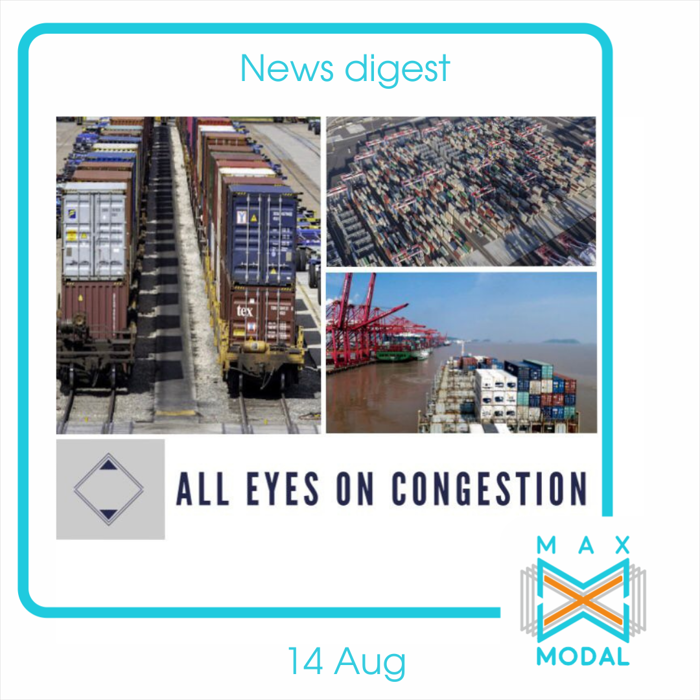News digest. 14 Aug
Is it possible to learn from past mistakes and avoid Yantian 2.0? Once again, congestion is in the spotlight.
Is the new Yantian looming over the horizon or is there a chance that the Ningbo congestion will be less harmful? Whatever the future holds, shippers are beginning to divert from Ningbo to Shanghai as the MSICT gets closed due to the new COVID cases. However, companies hope that the spread will be taken under control. Luckily, MSICT accounts only for 19% of the total container volumes at Ningbo, so if the shutdown is limited only to the facility, the situation will be manageable. Those who have already been through Yantian are not so positive - companies warn that Ningbo’s closure will worsen equipment shortages in East China and cause added ripples for reefer slot shortage at terminals in the region. The fears also concern the possibility of the blockage to spill beyond these ports: 40 container vessels waiting at the outer Zhoushan anchorage have already been reported.
Meanwhile, Maersk announces the implementation of new congestion surcharges: CFD and Congestion CFO in the ports of Rades and Tunis in Tunisia; a congestion fee of US$150 per 20' and US$200 per 40', 45' and high cube dry and reefer boxes in Paraguay, and so on.
Moreover, 2M Alliance has revealed several reschedules in two of its services that connect Far East Asia with North Europe. It will restart the AE1/Shogun Ningbo and AE6/Lion Shanghai Westbound calls to mitigate the impact of the congestion on its customers.
Even though the regional and transshipment ports are struggling, there is an improvement in the Chittagong port that is now free of vessel crowding. The authorities have also confirmed that the waiting time of container vessels has now gone down to less than 24 hours or one day at max.
Better late than never - the Port of Long Beach that has been struggling for the whole year and broken its record for handling enormous numbers of TEU has finally realized the need for a new strategic approach. Operating around the clock to keep up with anticipated growth is now in the talks. It is expected that most players along the supply chain would embrace an extension of operations to 24 hours.
These days trying to book container shipments is a nightmare as companies are practically torn between the five providers whose indexes vary greatly. The mess is also due to the fact that some outlier data is now being excluded to more accurately reflect market conditions. This resulted in a significant one-time adjustment that removed outliers and substantially increased rates on China/ East Asia-US FBX lane. Going from bad for worse?
The storm in Europe is not really over. Although the GDL’s strike in Germany has ended, delays and cancellations of trains have seriously impacted traffic to and from the Netherlands, and it will take a while to get back on track. Moreover, the strike affected mainly the connections to Poland and the Czech Republic.
Airfreight rates are back at it again. After some cooling down on a sequential basis in June, July saw them rise again on major intercontinental lanes due to a holiday peak. HKG to Europe and PVG to Europe basket indices rose 44% and 33% year-over-year in July, while HKG to North America and PVG to North America rose 59% and 51% year-over-year.
Life for the Dutch shippers is expected to get tougher as the Netherlands begins the roll-out of its new customs declaration system. Soon big companies will have to notify Customs before goods are entered into declarants’ records, unlike the old system The adjustments will require more time which is a luxury for the struggling companies in the current context.
With intermodal blooming, ironically, there are not enough intermodal terminals, thus, Poland will build a new one in Bydgoszcz, which has the potential to be an upgrading point for the Baltic-Adriatic corridor. For the financing, local governments and entrepreneurs are waiting for the release of the European fund for the long-term budget and funds from the Next Generation EU.
Konecranes has ordered six RTG cranes from Gemadept-Terminal Link CaiMep Terminal JSC in Vietnam that, in fact, will be fully electric machines, equipped with cable reels for zero local emissions. The Port of Liverpool has followed and welcomed four new CRMG cranes as part of the $554 million Liverpool2 project.
To help dredge key Delta channels within the Fraser River communities, the Vancouver Fraser Port Authority committed to providing a $7 million interim dredging solution. The initiative will make it easier for vessels to safely navigate and potentially can help local biodiversity.
Parcel deliveries, as well as the whole sector, have been in the spotlight under severe pressure all these months. In particular, the demand on the delivery sector was specifically intense. However, the hard work and effort of the companies have paid off - DHL, XPO, Great Bear and UPS have been announced the top five logistics companies in the UK by the CILT.

